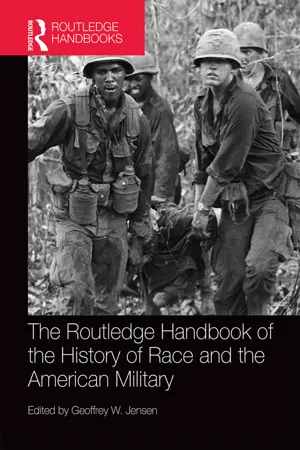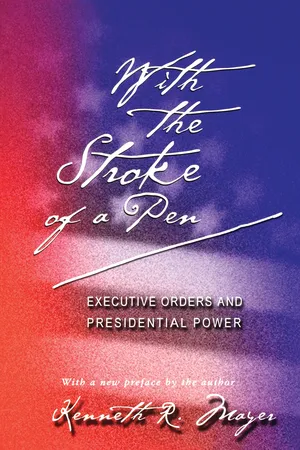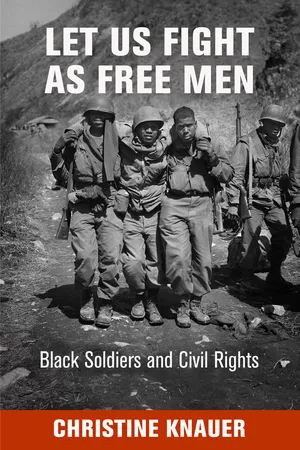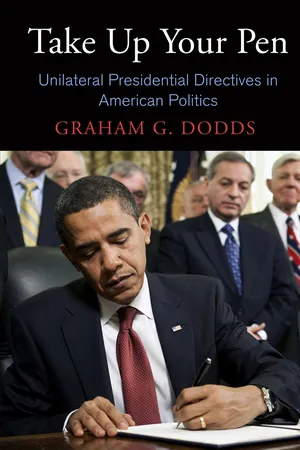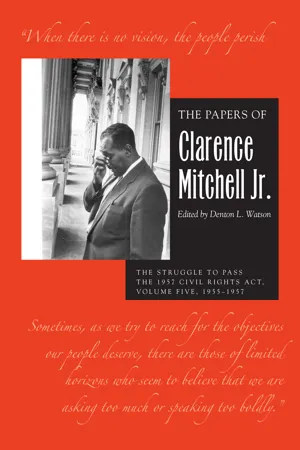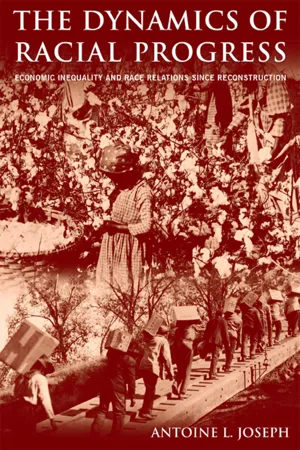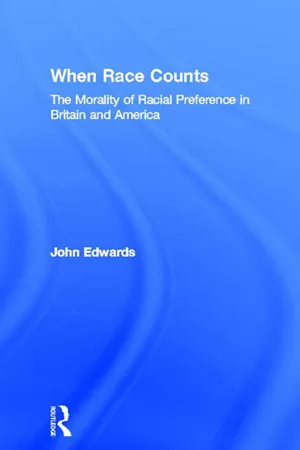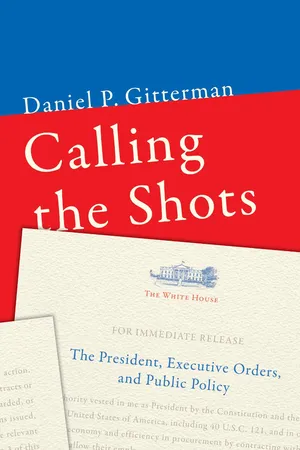History
Executive Order 9981
Executive Order 9981, signed by President Harry S. Truman in 1948, abolished racial discrimination in the United States Armed Forces. This landmark order marked a significant step towards desegregation and equality within the military, and it laid the groundwork for the broader civil rights movement in the United States.
Written by Perlego with AI-assistance
Related key terms
8 Key excerpts on "Executive Order 9981"
- Geoffrey Jensen, Geoffrey Jensen(Authors)
- 2016(Publication Date)
- Routledge(Publisher)
Brown decision, the providing of integrated health care for African American soldiers and their families, and the desegregation of the Veteran’s Administration and the National Guard and reserves. All of which owe, in some part, to Truman’s order, an enterprise brought on by a host of rationales that proved to be his most enduring triumph, a social victory that transformed and ultimately transcended the American Armed Forces.Notes
1 Aspects of this work first appeared in my dissertation. See Geoffrey W. Jensen, “It Cut Both Ways: The Cold War and Civil Rights Reform Within the Military, 1945-1968 (Ph.D. dissertation, University of Arkansas, 2009). Several historians have recently questioned aspects of Truman’s civil rights agenda, specifically his executive order desegregating the military, often interpreting them in a more critical light that shortchanges the man and the results. For example, Carol Anderson’s Eyes off the Prize (New York: Cambridge University Press, 2003), 3, while tipping its cap to the effort of the president condemned his actions as “the politics of symbolic equality” and therefore, Truman failed to “come even close to what needed to be done.” Christine Knauer’s Let Us Fight as Free Men: Black Soldiers and Civil Rights (Philadelphia: University of Pennsylvania Press, 2014), 53, deemed the president’s position on the matter to be “ambivalent”, while “his actions lagged behind his words.” Worse yet, though it fostered the potential for reform, “it did not result in decisive and far-reaching actions on behalf of black equal rights.”; See also, Geoffrey Jensen. Review of Knauer, Christine Let Us Fight as Free Men: Black Soldiers and Civil Rights. H-War, H-Net Reviews. November 2014. URL: www.h-net.org/reviews/showrev.php?id=42375- eBook - ePub
With the Stroke of a Pen
Executive Orders and Presidential Power
- Kenneth R. Mayer(Author)
- 2021(Publication Date)
- Princeton University Press(Publisher)
55In issuing E.O. 9981, Truman stepped into a process that had been emerging since the end of World War II. It was less a revolutionary policy change than it was a critical step in harnessing the developing momentum and establishing concrete steps to carry out the task of nondiscrimination: “By placing presidential authority squarely behind an official commitment to end such discrimination [in the military], and by publicly stating that he sought to eliminate racial segregation from the military, Truman broke with prior national policy and altered the course of the debate. His intervention emboldened advocates of racial equality, put supporters of segregation on the defensive, and opened a path leading toward the completion of formal racial integration.”56Compared with Truman, Eisenhower was less inclined to rely on executive power to promote a civil rights agenda. Nevertheless, the executive orders in the 1940s had firmly established that the presidency was the focal point of racial progress, and the Eisenhower White House recognized that a retreat was politically impossible. In his 1953 State of the Union Address, Eisenhower pledged his dedication to “equality of opportunity for all,” and promised to use “whatever authority exists in the office of the president” to end segregation in Washington, D.C., in federal government employment, and in the military. It is clear, though, that Eisenhower took a restrictive view of how far that authority would extend. During the 1952 campaign, he told Herbert Brownell that if elected he would work to end discrimination in those areas under federal jurisdiction. Although Eisenhower took a progressive stance on the issue, Brownell found that “the qualifier federal jurisdiction was quite limiting in his 1952 position.”57 - eBook - ePub
Let Us Fight as Free Men
Black Soldiers and Civil Rights
- Christine Knauer(Author)
- 2014(Publication Date)
- University of Pennsylvania Press(Publisher)
Chapter 5Truman’s Order
The pressure on the president to make decisive changes mounted, as the chances of winning over the increasingly important black vote in the upcoming presidential election became more difficult. At the end of June 1948, an anonymous White House memorandum recommended that Truman “support the introduction of moderate [civil rights] legislation beating the Republicans to the punch” and garner “credit.”1 The president felt it necessary to act, but followed a slightly different route. On July 26, he issued Executive Order 9981, which called for the “equality of treatment and opportunity for all persons in the Armed Services without regard to race, color, religion, or national origin.”2 Since executive orders do not require the approval of the House or Senate, Truman circumvented painstaking discussions and the likely rejection of any such civil rights legislation in Congress.3 Contrary to numerous accounts and after-the-fact interpretations, the presidential order did not officially demand the immediate and complete desegregation or integration of the military. Instead, it established the President’s Committee on Equality of Treatment and Opportunity in the Armed Services, later known as the Fahy Committee, to ensure the order’s implementation and to force the armed services to change.4 - eBook - ePub
Take Up Your Pen
Unilateral Presidential Directives in American Politics
- Graham G. Dodds(Author)
- 2013(Publication Date)
- University of Pennsylvania Press(Publisher)
Richard Nixon continued the use of unilateral presidential directives for affirmative action policies. For example, Nixon's Department of Labor issued “Revised Order #4,” which revised LBJ's Executive Order No. 11,246 by extending the “Philadelphia Plan,” which required some federal contractors in some cities to establish goals and timetables for minority hiring. And Nixon's Executive Order No. 11,478 of August 1969 prohibited racial discrimination in the federal government's civilian workforce.In 1980, Jimmy Carter issued two executive orders to advance policies concerning race. In August, he created the official designation “historically black colleges and universities” (HBCUs) and sought to ensure that such schools enjoyed various benefits from federal programs.102 And two days before the presidential election of 1980, Carter issued an executive order to facilitate consistent and effective implementation of various laws prohibiting discrimination by having the attorney general coordinate such efforts.103Subsequent presidents sought to use unilateral directives to curtail affirmative action. For example, Ronald Reagan considered rescinding LBJ's Executive Order No. 11,246, but in the end Reagan's Department of Labor merely issued regulations to modify it. George H. W. Bush also sought to use a unilateral directive for that purpose. Shortly after the controversial and racially charged Senate confirmation hearings in 1991 concerning Justice Clarence Thomas's nomination to the Supreme Court, Congress and the White House agreed on a compromise civil rights bill. The day before Bush signed the legislation into law, however, he issued an order to all federal agencies to end programs involving quotas, preferences, or setasides. The order was reportedly just a draft and was intended to be included in Bush's signing statement for the civil rights bill, but when critics charged that Bush was effectively using an executive order to repudiate the same legislation that he was signing, the president withdrew the order and modified his signing statement.104 And in 1995, one month after the Supreme Court decided to subject all racial classifications to “strict scrutiny” in Adarand Constructors, Inc., v. Pena, 515 U.S. 200, Bill Clinton issued a presidential memorandum calling for the elimination of affirmative action programs that created a quota, established a preference for unqualified people, or had outlived their purposes.105 - eBook - ePub
The Papers of Clarence Mitchell Jr., Volume V
The Struggle to Pass the 1957 Civil Rights Act, 1955–1958
- Clarence Mitchell Jr., Denton L. Watson, Denton L. Watson(Authors)
- 2022(Publication Date)
- Ohio University Press(Publisher)
Wright’s ultimate mission was to commemorate the end of slavery and the adoption of the Thirteenth Amendment, which occurred on February 1, 1865, with the application of President Lincoln’s signature. The purpose of National Freedom Day was to promote goodwill, harmony, and equal opportunity among all citizens and to rededicate the nation to the ideal of freedom. 161 Truman further significantly strengthened his civil rights credentials by issuing on July 26, 1948, Executive Order 9980, creating a Fair Employment Board, and Executive Order 9981, creating the President’s Committee on Equality of Treatment and Opportunity in the Armed Forces. The struggle for the order barring discrimination in government employment was led by Mitchell, while that barring segregation in the military was led by Randolph. Regarding the FEPC-type order, Truman decreed that “merit and fitness should be the only application for a government job,” and that the head of each department “shall be personally responsible for an effective program to ensure that fair employment policies are fully observed in all personnel actions within the departments.” 162 The New York Times commented that the “two orders were expected to have a thunderbolt effect on an already highly charged political situation in the Deep South.” It said the situation, the following day, was “expected to be aggravated further when Mr. Truman makes his omnibus call on Congress for action. The message, in one of its 11 major elements, is expected to go down the line for the ten-point civil rights program, which last February started the deep fissure in the Democratic Party.” 163 Truman’s actions were not unnoticed by African Americans - eBook - ePub
The Dynamics of Racial Progress
Economic Inequality and Race Relations Since Reconstruction
- Antoine L. Joseph(Author)
- 2016(Publication Date)
- Routledge(Publisher)
36Congressional support for civil rights began to rise as well. Members of Congress introduced bills to give Executive Order 8802 legal backing and to extend the prohibition against discrimination to private employers and labor unions. The 1940s also saw the political defeats of a number of diehard segregationists, most notably Senator “Cotton Ed” Smith of South Carolina.The Supreme CourtDuring the 1940s a series of Supreme Court rulings began to dismantle the constitutional protection of segregation. In Smith v. Allwright, 1944, the Court ruled that all-white primaries were unconstitutional. In Morgan v. Virginia, 1946, the Court banned segregated seating on interstate buses. The Court found segregation impermissible in publicly supported higher education in two cases decided in 1950, Sweatt v. Painter and McLaurin v. Oklahoma.Sweatt v. Painter was a dramatic breakthrough in the attack on segregation. Victorious NAACP lawyers believed this decision set school segregation on the road to extinction. Conservative Chief Justice Fred Vinson wrote the majority opinion that Jim Crow schools were unlikely to ever be equal to long standing state schools. In a speech at Fisk University, Thurgood Marshall argued, “Despite the fact that the Separate-But-Equal doctrine was not technically overruled by these decisions, the force and significance of the languages certainly robs the doctrine of most of its validity.… We now have the tools to destroy all governmentally imposed racial segregation.”37 With Sweatt, the momentum favoring racial integration was clearly accelerating. The Baltimore Afro-American’s headline announcing the Sweatt decision expressed a view that was rapidly gaining strength among supporters of integration: “End of Jim Crow in Sight.”38 - eBook - ePub
When Race Counts
The Morality of Racial Preference in Britain and America
- John Edwards(Author)
- 2005(Publication Date)
- Routledge(Publisher)
5The real thingThe American way with affirmative actionIt should come as no surprise that affirmative action in the United States did not spring perfectly formed from any Statute or Presidential Executive Order. True, it made its first appearance in President Kennedy’s Executive Order No. 10925, but only as a rhetorical flourish; it meant little more than desisting from discriminatory actions. Only in the subsequent decade did it become formalised into a pattern of particular requirements that meant more than just not discriminating. It would be quite wrong, therefore, to see the first appearance of the term ‘affirmative action’ in 1961 as some sort of landmark in the history of race-conscious policy in America. Executive Order 10925 was important for a number of reasons, but it was one step in a journey that had effectively begun in 1941 for purposes that had far more to do with the necessities of the war effort than with any concern for racial justice or equity.In 1941 America was falling behind with wartime production schedules, in large part because of a shortage of workers. Many of the war-related industries were heavily unionised and excluded women and minorities from the workforce; a large pool of labour was therefore being excluded from a labour-hungry war effort. It was in the face of this potentially damaging situation that President Roosevelt issued Executive Order 8802 which stated in part: ‘that there shall be no discrimination in the employment of workers in defense industries or government because of race, creed, color or national origin’. It went on to assert that it was the duty of employers and labour organisations ‘to provide for the full and equitable participation of all workers in defense industries’. And the rationale for all this was ‘the firm belief that the democratic way of life within the Nation can be defended successfully only with the help and support of all groups within its borders’ (all quotations from Presidential Executive Order 8802 25 June 1941). It was this Order that inaugurated the idea of contract compliance which has remained in a variety of forms the principal arena for the practice of affirmative action to the present day. It contained two elements. First that all further contracts between government agencies and contractors must include non-discrimination clauses. Second, it established the Committee on Fair Employment Practice in the Office of Production Management. This committee was partly advisory (to the President and government agencies) but could also receive complaints of contract violation. It did not, however, carry any enforcement powers and some contractors, particularly those that were the sole source for some materials, were able to continue discriminatory practices with impunity. Nonetheless, minority and female participation in the labour force (including contractor establishments) increased markedly during the war years, either in part as a result of EO 8802 or simply because of labour market forces. What is significant is that the progress was transitory. Veterans returned at war’s end and reclaimed their jobs and minority and female participation rates plummeted. In 1946 the Committee on Fair Employment Practice recorded in its valedictory report that ‘wartime gains of Negro, Mexican-American and Jewish workers are being lost through an unchecked revival of discriminatory practices’ (Committee on Fair Employment Practice 1947:VIII, as quoted in Office of Federal Contract Compliance Programs 1984). By 1953, the President’s Committee on Government Contract Compliance (the successor body to the Committee on Fair Employment Practice) found ‘the non-discrimination provision [in Government contracts] almost forgotten, dead and buried’. Non-discrimination had not survived the exigencies of the war effort. Discrimination had once again become normal practice, a way of life in the labour market. And still, of course, a way of life—especially in the south. Brown v. Topeka Board of Education and Little Rock - eBook - ePub
Calling the Shots
The President, Executive Orders, and Public Policy
- Daniel P. Gitterman(Author)
- 2017(Publication Date)
- Brookings Institution Press(Publisher)
19Truman proposed a ten-point plan for civil rights reform, but Congress balked.20 So Truman took executive action.21 Truman required each federal agency to establish an equal employment program for its employees; to ensure that all personnel actions by federal appointing officers be based solely on merit and fitness; and to take appropriate steps to prevent discrimination due to race, color, religion, or national origin. Truman established the Fair Employment Board to review cases from federal agencies and issue periodic reports to the president. Additionally, Truman required the desegregation of all federal agency dining rooms.22 Truman’s order initiated change in the diversity of the federal workforce.23 Despite the positive effects within some agencies, Truman faced political resistance from other federal agencies. For example, the Treasury Department resisted hiring blacks in the Bureau of Engraving and Printing. Truman pushed back, and mandated that the bureau hire black candidates.24When Eisenhower won the 1952 election, Congress remained resistant to civil rights reform. Eisenhower was more reluctant than his Democratic predecessors to issue antidiscrimination orders. Although he supported equal rights, he “believed equally strongly in limited government.”25 Like his two immediate predecessors, however, he faced increasing demands from civil rights groups.26 Eisenhower abolished Truman’s Fair Employment Board and established the President’s Committee on Employment Policy.27 Eisenhower claimed it was “the policy of the United States Government that equal opportunity be afforded all qualified persons, consistent with law, for employment in the Federal Government” and reaffirmed “with respect to all personnel actions in the executive branch, that there shall be no discrimination because of race, color, religion, or national origin.”28
Index pages curate the most relevant extracts from our library of academic textbooks. They’ve been created using an in-house natural language model (NLM), each adding context and meaning to key research topics.
